The post 10 Places to Visit in Croatia (That Aren’t Dubrovnik) appeared first on The Blonde Abroad.
from The Blonde Abroad https://ift.tt/3mUlqR4
The post 10 Places to Visit in Croatia (That Aren’t Dubrovnik) appeared first on The Blonde Abroad.
The post The Ultimate Savannah Foodie Guide appeared first on The Blonde Abroad.
The post Staying at Montage Palmetto Bluff in South Carolina appeared first on The Blonde Abroad.
The post The Ultimate 3-Day Savannah Guide appeared first on The Blonde Abroad.
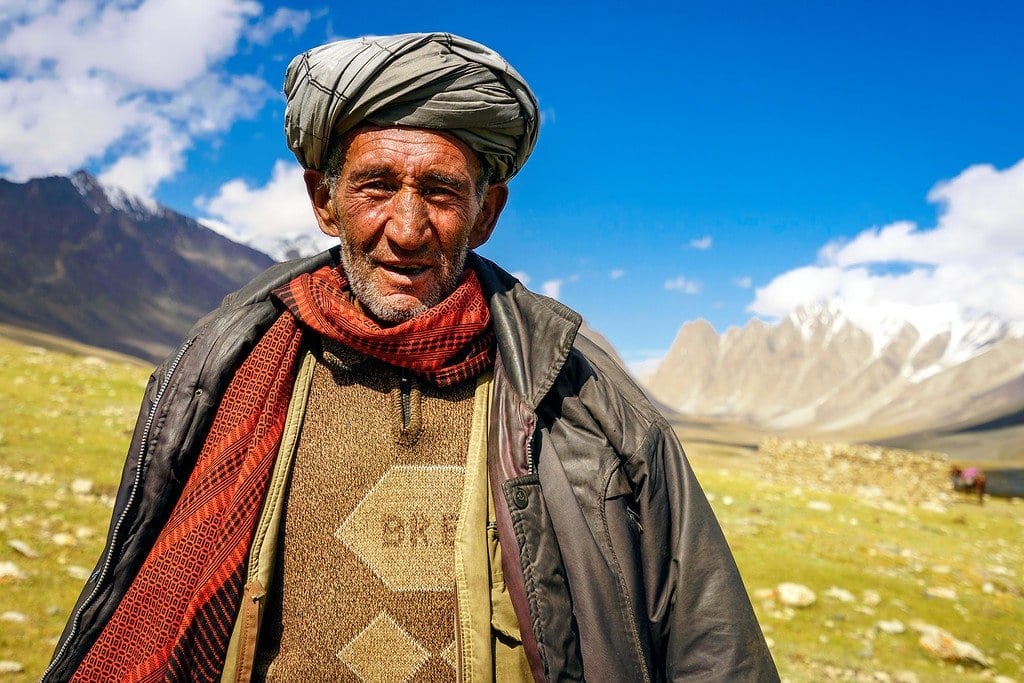
In 2016 I traveled into the mountains of Afghanistan for a two-week backpacking adventure. Not your typical summer vacation destination. Here’s what I witnessed.
What comes to mind when you think about Afghanistan? War? Terrorism? Osama Bin Laden? The Mother Of All Bombs?
Much of Afghanistan is still dangerous — but there’s also incredible beauty, hospitality and kindness that doesn’t get reported on.
It’s far too easy to vilify or write-off an entire nation when you don’t have to look those people in the eyes. People with the same hopes and dreams as you — to survive, find happiness and provide for their families.
I was able to experience the positive side of Afghanistan and its wonderful people, up close and personal, during my trip there last summer. It’s since become my most memorable travel adventure to date.
Here are some of my favorite photos of people & landscapes from my 100-mile backpacking trip into Afghanistan’s remote and mountainous Wakhan Corridor.
This is the “other” side of Afghanistan that you don’t see in the news.


The Wakhan is a rugged and wild region of Northeast Afghanistan, part of Badakhshan Province. It’s a narrow piece of land, about 400 km long, surrounded on three sides by Tajikistan, China, and Pakistan.
Two large mountain ranges dominate the area, the Pamir in the North, and the Hindu Kush in the South. The Wakhan Corridor was created by politicians in the 1800’s during the “Great Game” in an attempt to leave a buffer zone between British India and the Russian empire.

Traveling by foot with my backpack, I managed to take a break hitching a ride on a yak for a portion of the route. We ran into a group of Wakhi men leading their yaks through the mountains. While they stopped for tea, they let us borrow their yaks, which we led further into the valley until their owners caught up with us later.
Yaks are the ultimate eco-friendly 4×4 in Afghanistan, able to climb steep rocky terrain and power through icy cold rivers. There are no trees above 10,000 feet, so locals are forced to trek for 3 days to lower elevations with their animals in order to gather firewood for cooking and warmth.


The Wakhan was once part of the ancient silk road, an important trading route connecting China to Europe. Along with silk, horses, and other goods, it was a highway for armies and explorers too. Explorers like Marco Polo who is believed to have passed through here during the 13th century.
Crossing steep mountain passes and high desolate plateaus, passing caravans of yaks and donkeys loaded with goods, spending the night in stone shelters with traveling merchants — I felt like I was getting a glimpse of what the silk road must have been like all those years ago.
READ MORE: 17 Useful Travel Photography Tips


Just like the many different branches of Christianity, there are many different branches of Islam, all with their own beliefs and values. Many people living in Afghanistan’s Wakhan Corridor are Ismaili Muslims, who practice a moderate form of Islam. They number 25 million worldwide, and despise the Taliban.
Their spiritual leader is the Aga Khan, a successful British businessman and Imam who runs the Aga Khan Development Network, a super important charity organization that improves living conditions and opportunities for the poor in Africa and Central Asia.
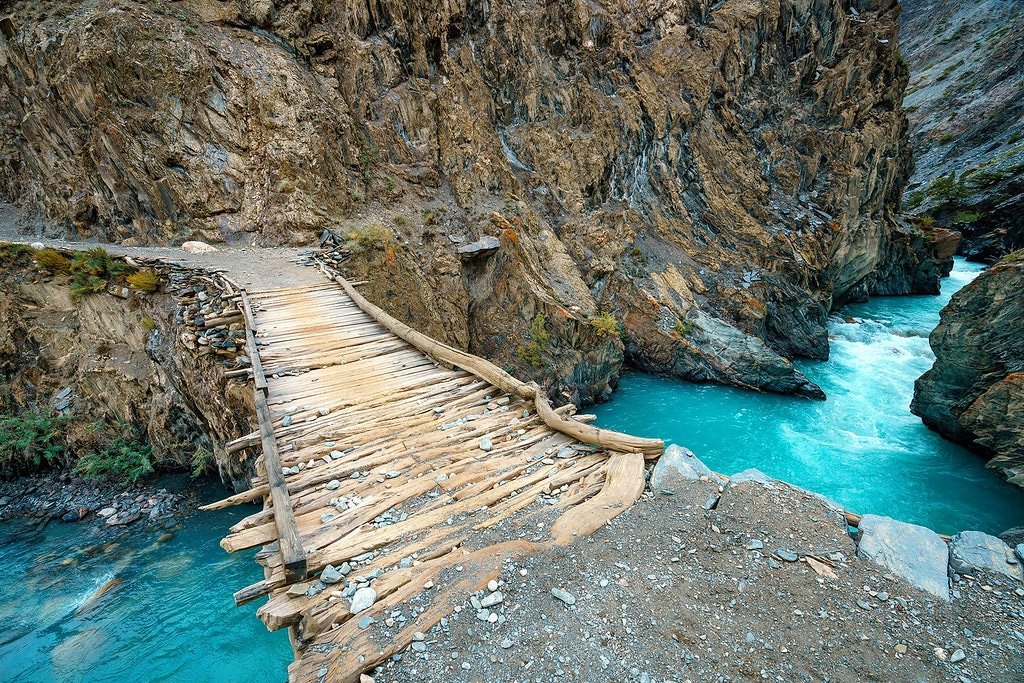
The Wakhan River runs through the Wakhan Corridor, fed by the high altitude mountains of the Hindu Kush on the border with Pakistan. It snakes its way through the mountains and is a major lifeline for the people living in this harsh and unforgiving landscape.
The bright blue color of this water is due to reddish hues of the rock formations around it, as well as the crystal clear source (a glacier). Water molecules absorb other colors, like red, more efficiently than blue.
READ MORE: How To Pick A Travel Backpack
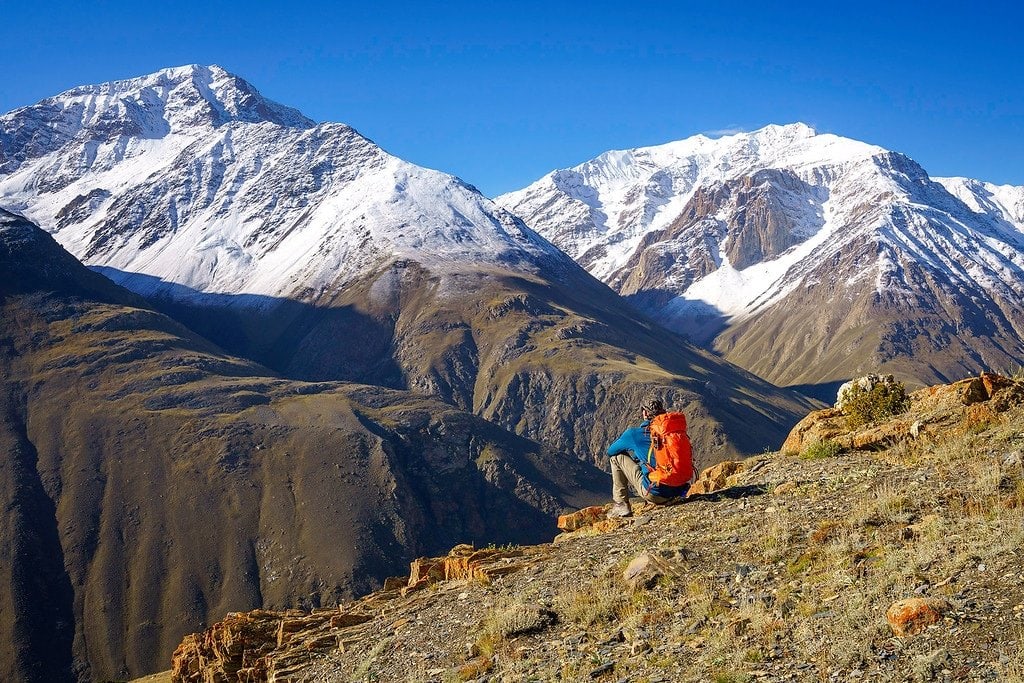
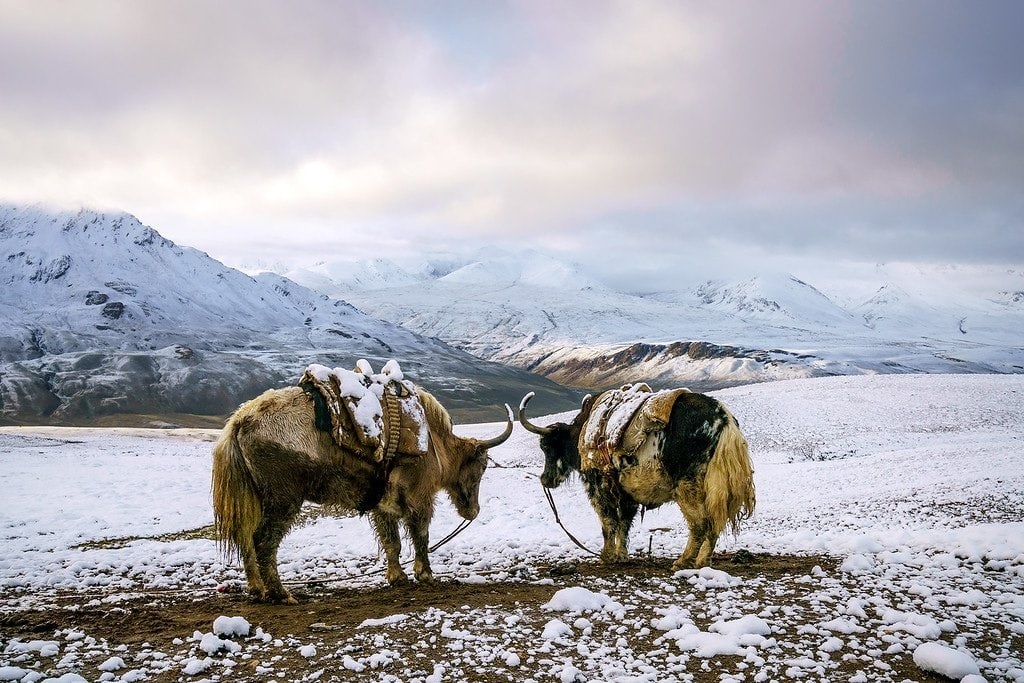
When the weather was clear, I was rewarded with incredible views of the mountains like this! The trail was well worn, as it’s used daily by small groups of locals who travel in caravans of yaks or donkeys from settlement to settlement.
The 10 day trek ranged in altitude from 10,000 to 16,000 feet, and we averaged about 10 miles per day of hiking. I began to feel the effects of altitude on my body around 12,000 feet with shortness of breath. At 16,000 feet hiking became even more tiring and difficult.


The Kyrgyz people of Afghanistan are semi-nomadic, moving from valley to valley herding their animals to different grazing pastures depending on the season. They live in cozy yurts made of sheep felt, which can be broken down and transported long distances.
Each settlement consists of 2-3 families living and working together. Originally from the area around Kyrgyzstan, their ancestors were kind of trapped in the Wakhan after the Soviets took over Central Asia, forcibly settled nomadic tribes, and sealed off the silk road route.
READ MORE: How To Visit The Afghan Wakhan

Both the Wakhi and Kyrgyz people drink large amounts of salty milk tea, called Sheer Chai. It’s served for breakfast, lunch, and dinner. Basically, it’s a mix of yak and goat milk, boiled down for hours and dried into a portable block. It’s prepared by adding boiling water, loose-leaf tea, and rock salt.
The salt is great for rehydration at high & dry altitudes — I called it my Afghan Gatorade. It took a while to get used to (salty hot milk anyone?), but by the end of the adventure my body was craving sheer chai for every meal. You can also dissolve raw butter into the tea at breakfast for extra calories.

Near the end of my 2nd day on the trail, we hiked past a set of ancient petroglyphs scrawled into a dark colored boulder overlooking the valley. My local guide, Yar, couldn’t tell me much about them, other than they think these markings are a few thousand years old.
They depict hunting scenes, men armed with what appear to be bows, as well as large game like ibex and the rare Marco Polo sheep. This was just one of many petroglyphs that dot the landscape in these mountains. They are thought to mark ancient hunting grounds claimed by different tribes.


This simple 3 room school in the remote Afghan village of Bozai Gumbaz was built by Greg Mortenson and his Central Asia Institute. You may have heard of Greg before, he’s the author of the best selling novel Three Cups Of Tea, about building schools for girls in Pakistan.
The school at Bozai Gumbaz, where I spent the night playing cards with Afghan army soldiers, was prominent in his 2nd book, Stones To Schools. The next morning a group of boys showed up on donkeys for class. I saw many CAI schools along the road from Eshkashim to Sarhad-e Broghil.

As a big fan of the outdoors, one of the highlights on this trip was the opportunity to wild camp in the mountains of Afghanistan. Most nights we were able to stay at small Wakhi or Kyrgyz settlements in basic guest huts, but we also camped out in tents a few nights too.
Normally I’m a camping hammock kind of guy, but because I knew there weren’t going to be any trees for most of this trek, I packed my super lightweight Nemo Hornet 2P Tent. It snowed a few times during the journey — in August!
READ MORE: My Complete Travel Gear Guide


I was constantly greeted with As-salāmu ʿalaykum which means “peace be upon you”. A shorter version of this is just salām. Shaking hands is common, and so is placing your hand on your heart, which simply means your greeting comes from the heart.
Another important term I used during my journey is taschakor, meaning thank you. I always recommend trying to learn 10 of the most used words in a local language before traveling there. In the Afghan Wakhan, most people speak some Dari (Farsi) along with local dialects.


Many people were asking if I saw women in Afghanistan. Yes I saw women during my trip, but most were extremely shy, especially if I had my camera out. Plus in their culture, talking with strange men is taboo. But shooting portraits of men or kids was not a problem.
Near the border town of Sultan Eshkashim, with a large Sunni population, many women wear a full-length blue burqa that covers their face. In more rural areas of the Wakhan, it’s less strict. Women wear long colorful dresses with a simple headscarf. I was able to say hello and see their faces.

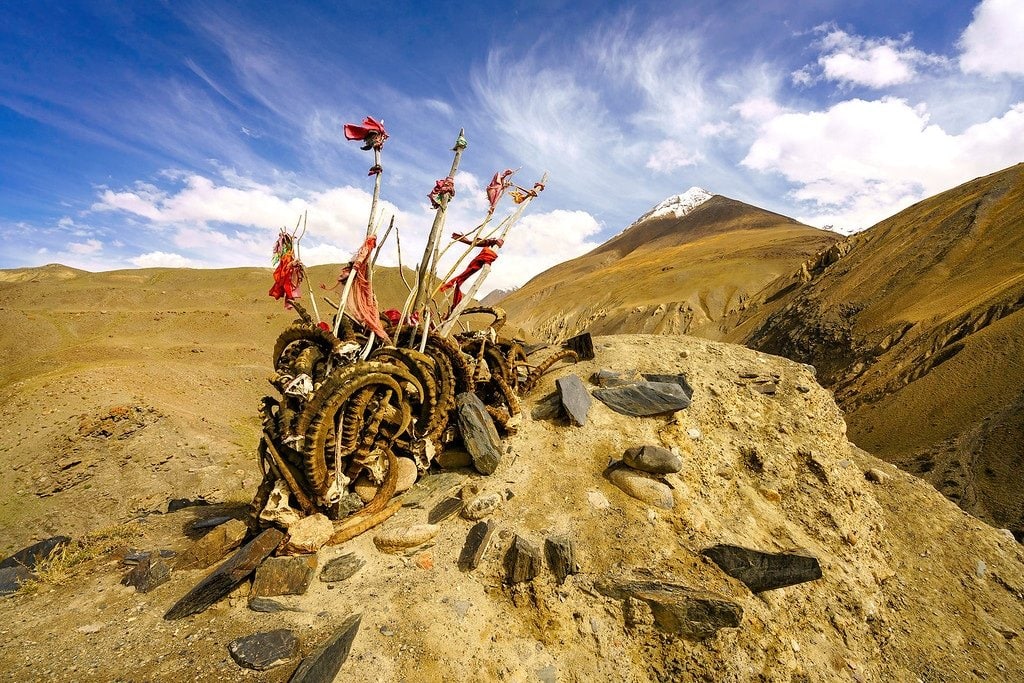
I encountered a few ancient burial tombs during my time exploring the Wakhan Corridor. Near the Afghan military outpost of Bozai Gumbaz, there’s a collection of strangely shaped Kyrgyz beehive tombs, along with evidence of Soviet bombing (craters, bomb fragments) from the 1980’s occupation.
At the settlement of Langar, we found a pile of ibex horns marking the burial place of a powerful big man. In Afghanistan, wealthy & powerful men are often called “big men”. It’s a bit like calling someone “boss.” The more animals, land, and wives you have, the “bigger” & more influential you are.

Before I began the 10 day, 100 mile trek through the mountains, I had to hire a 4×4 van to drive me to the last village at the end of the road. We passed a few military checkpoints along the way, stopping for tea & candy with officials before continuing on.
The drive took 2 days, and the roads were some of the worst I’ve ever seen. Dust seeped into the vehicle, covering us in dirt. We forded rivers, drove along the edge of sheer cliffs, and were frequently stopped by huge herds of goats blocking the road. The van suffered 6 flat tires during the journey.


While I entered Afghanistan alone, I decided to hire a local translator/guide and horseman to accompany me on the trek into the mountains. It would have been extremely difficult to communicate with others without their help. We spent a few nights at Wakhi settlements during the hike.
Wakhi homes are basically stone huts with dirt floors, constructed using manure for cement. The roof is made of logs, grass, and more manure to keep it waterproof. Some shelters had stoves inside, others just had a fire pit. Either way it was pretty smokey inside with a fire…


Life in the Wakhan is rough, especially for kids. About 60% of children here die before the age of five, the highest infant mortality rate in the world. If they do survive, they are put to work helping out with the family business — animal herding.
There are a few schools out here, thanks to the Central Asia Institute, but it’s up to the parents if they go. In some communities, only the boys are sent to school. The morning commute can take a few hours by donkey due to the lack of roads and distance between settlements.

I was really hoping to see a snow leopard or Marco Polo sheep while I was traveling through the mountains of Afghanistan’s Wakhan Corridor. You know, Walter Mitty style! Unfortunately both of these endangered animals are extremely difficult to spot — but I did find camels!
Luckily the Wildlife Conservation Society has staff in the area, often spending weeks in the field gathering data to protect wildlife in the Wakhan. They estimate there are about 100-200 snow leopards living in these mountains. Wolves and bears also call this wilderness home.

So there you go. A peek at the other side of Afghanistan that we never see on the nightly news. After traveling the world extensively for the past 6 years, I’ve noticed this is a common theme.
Don’t let our media, which is primarily focused on negative & sensational topics, be your only window into the dynamics of a foreign country you’ve never been to.
I’m not going to tell you that Afghanistan is safe. It’s not. Our troops who’ve served there can tell you. Afghans themselves are well aware of the dangers that plague their country too.
But I think there’s another side to Afghanistan that deserves some attention. The rugged, scenic mountain landscapes. The friendly, hospitable local people.
I’m hopeful for the day when Afghanistan’s problems fade away, and more travelers can safely enjoy the beauty this incredible country has to offer. ★
Subscribe to my YouTube Channel for new Adventure Travel Videos!
(Click to watch Backpacking Afghanistan – Wakhan Corridor on YouTube)

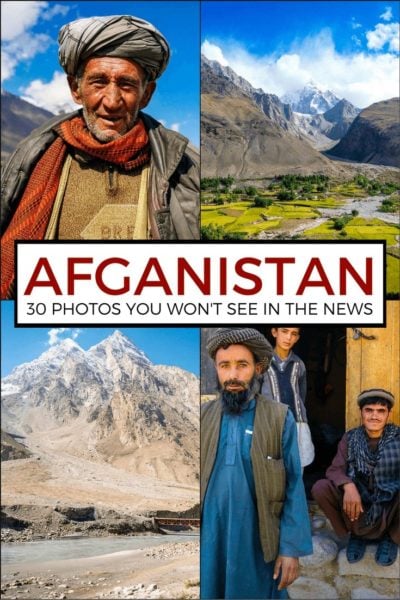
I hope you enjoyed my Afghanistan photos! Hopefully you also found this post useful. Here are a few more wanderlust-inducing articles that I recommend you read next:
Have any questions about Afghanistan? What do you think about traveling there? Drop me a message in the comments below!
This is a post from The Expert Vagabond adventure blog.
The post 3-Day Guide to Central Coast of California appeared first on The Blonde Abroad.
The post The Best Restaurants in San Diego appeared first on The Blonde Abroad.
The post Staying at Garza Blanca Resort & Spa in Los Cabos appeared first on The Blonde Abroad.
The post The Ultimate Two-Week Italy Itinerary appeared first on The Blonde Abroad.
The post Top Things to See and Do Grand Junction, Colorado appeared first on The Blonde Abroad.
The post The Ultimate 2-Day Berkeley Itinerary appeared first on The Blonde Abroad.
The post 10 Places to Visit in Greece (That Aren’t Santorini) appeared first on The Blonde Abroad.
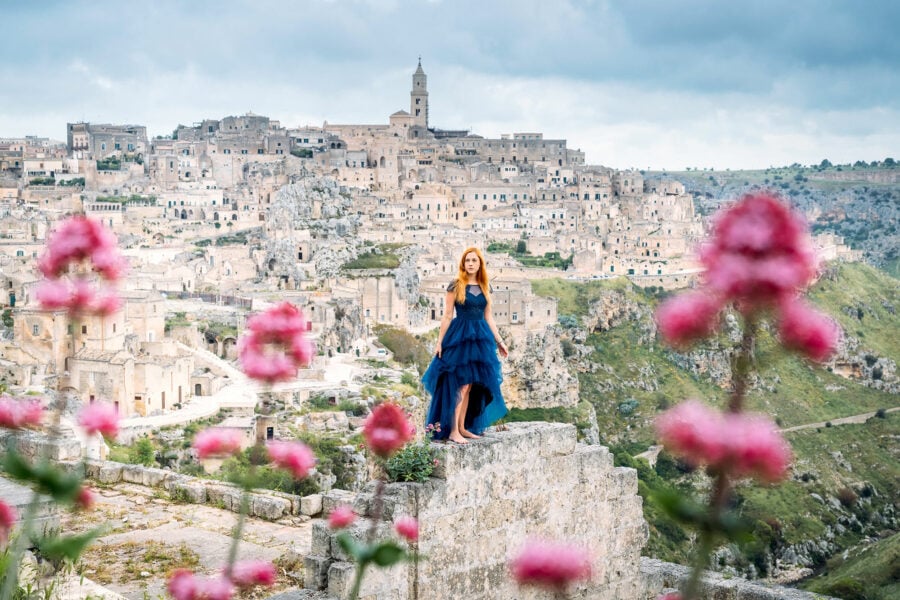
Matera is one of the coolest places we visited in Italy. An ancient town made of caves, carved into the side of a ravine! Here are some tips for cool things to do in Matera.
The town of Matera, Italy has a long and fascinating history. And I mean loooong.
It is one of the oldest continually inhabited settlements in the world, estimated to be settled in the 10th millennium BC (that’s about 10,000 years ago!). And sporadically settled for another 400,000 years before that…
So you’d think that because Matera is considered the 3rd oldest city in the world, it would be much more popular than it is.
But for a long time the poor people of Matera were forgotten and left to fend for themselves. The great “Shame Of Italy” it was called.
Once a painful reminder that Italy was considered a third-world country, with its residents living in squalor underground.
However Matera has seen a drastic turnaround and has been transformed into a unique tourist destination, along with an upcoming cameo in the new James Bond film “No Time To Die“.
After spending 3-days exploring this very cool town, I wanted to share some of the best things to do in Matera Italy if you’re planning a visit.
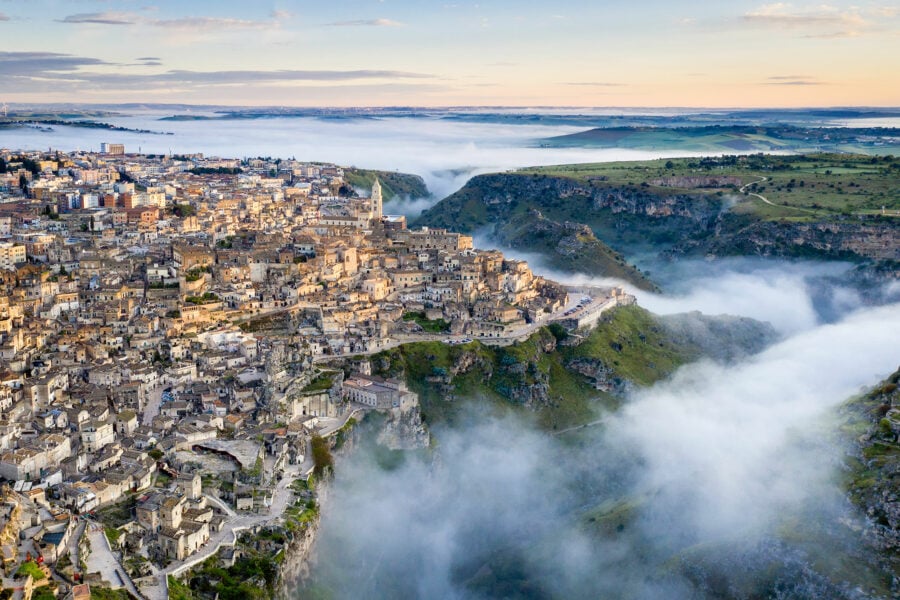
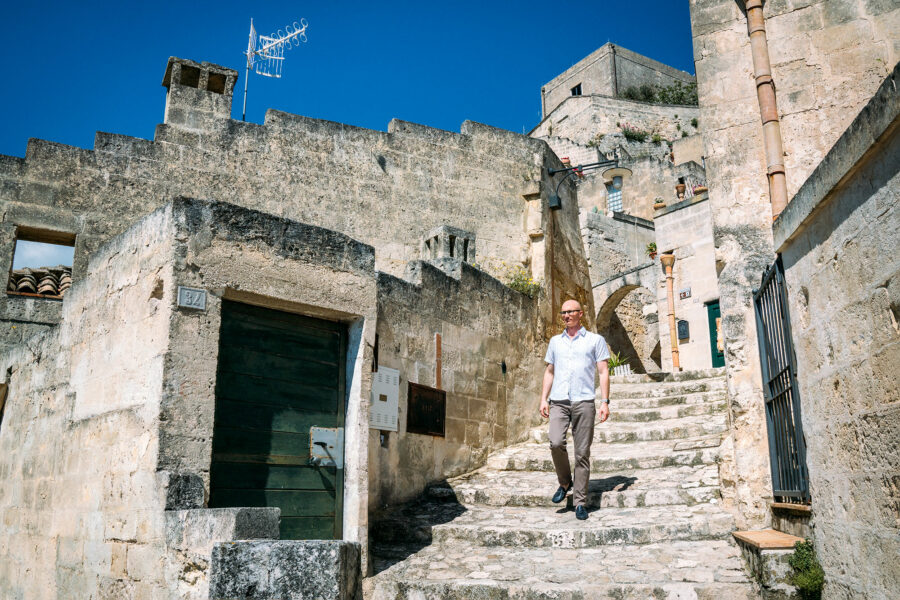
There are a few different versions of Matera you’ll encounter on your trip. The modern town, and two ancient neighborhoods known locally as sassi. The spectacular part of Matera are these sassi areas (a UNESCO World Heritage Site) — Sassi Barisano and Sassi Caveoso.
Matera’s sassi are grottoes carved out of limestone with homes built out in front of them. Buildings stacked on top of each other facing in all directions. Each neighborhood is a labyrinth of narrow alleys, staircases, and courtyards. It’s very easy to get lost! But that’s half the fun.
Sassi Barisano is the more developed of the two ancient neighborhoods, full of traditional restaurants, cave hotels, and art galleries. Sassi Caveoso on the other hand, has plenty of abandoned caves that give you a glimpse of what life really looked like here not that long ago.
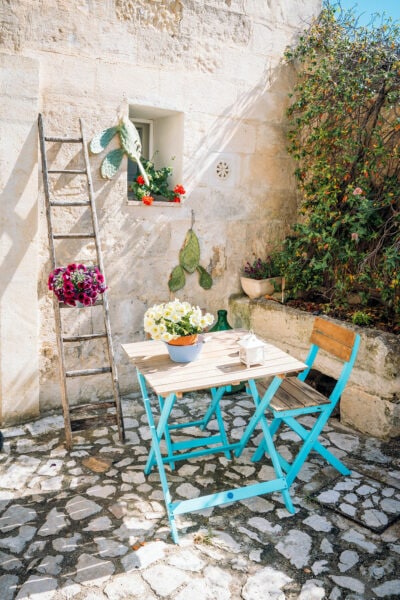
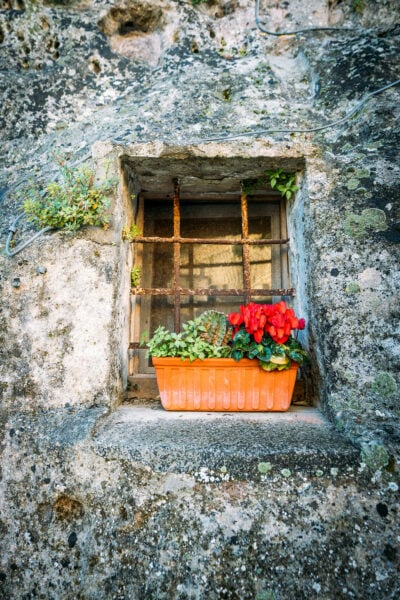
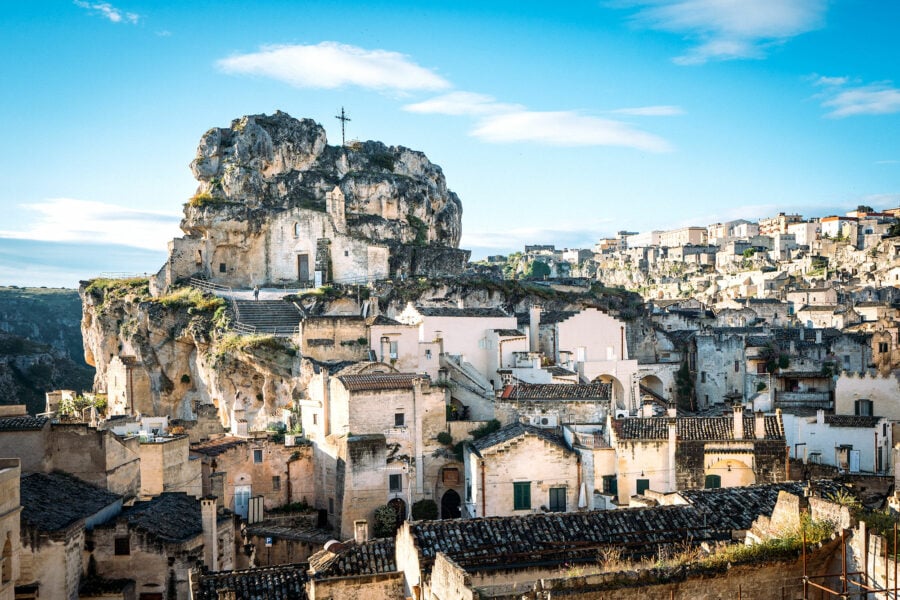
The Church of Saint Mary of Idris is one of the most unique attractions in Matera. Composed of two parts, one excavated from the rock itself, and one built, this church houses some colorful preserved frescoes painted between the 12th to 17th centuries.
San Giovanni in Monterrone is a crypt that’s attached to the church via a narrow tunnel. The entry fee for both the church & crypt complex is €5 EURO, and unfortunately no photos are allowed of the ancient frescoes within.
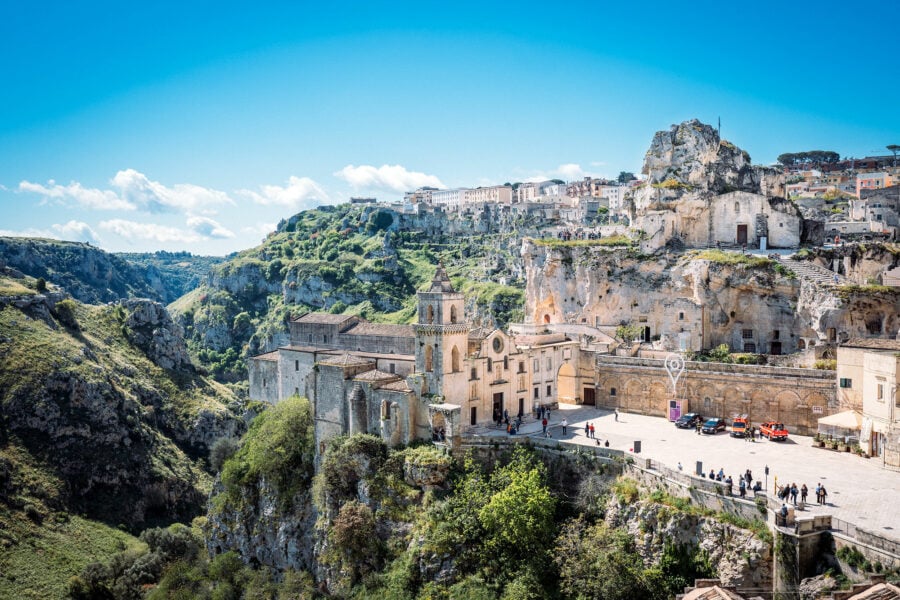
Church of Saints Peter and Paul, also known as “Caveoso”, is a church in Matera located in the Sasso Caveoso neighborhood. It was built back in the 13th century, but had been updated since then.
It sits on the edge of the ravine, giving it a pretty dramatic appearance. You can visit the church during normal daily liturgical celebrations.
Inside, there are 4 side chapels on the left side. There used to be 8, but some were demolished to make room for the construction of an oratory.
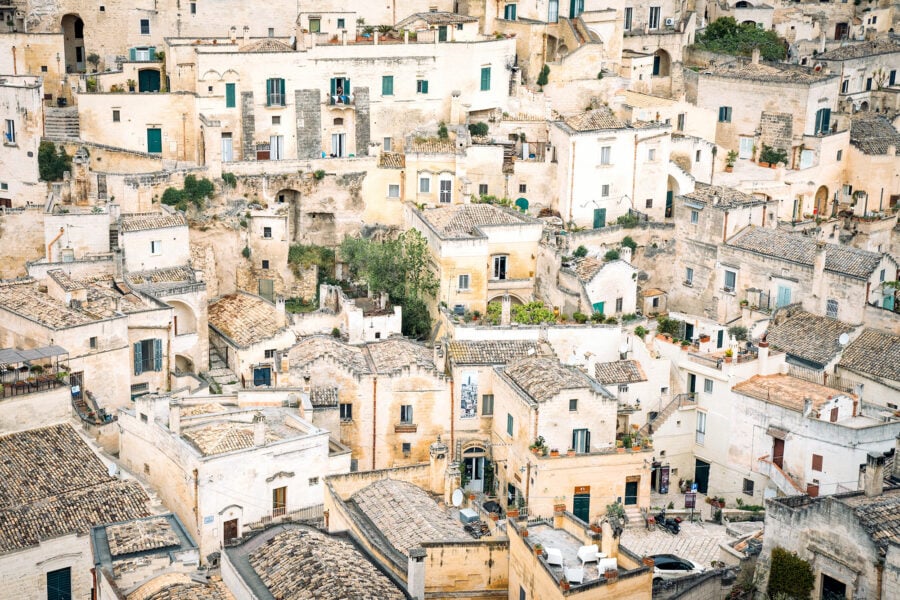
Casa Noha is a small museum and multimedia exhibit that gives you a glimpse of the slightly shocking history of Matera. The reason it was called the “Shame of Italy”. It’s a 30-minute experience split across three rooms and four different videos telling the story of Matera from the neolithic period to present day.
Located within an authentic cave house in the heart of the Sassi Barioso, the videos describe the heartbreaking poverty residents had to endure here — like families of 8 people forced to live in a 16-square foot cave with no running water, electricity, or proper sewage disposal. Or sleeping next to their livestock.
It’s an excellent introduction to Matera, and gives you more context for the rest of your visit as you wander through the town.

If you look carefully across the ravine from Matera, you’ll notice a series of caves built into the side of a green hill. These caves are the original homes of the first Paleolithic settlers here, carved out over 10,000 years ago.
It’s possible to hike down some steps to a bridge over the ravine from Parcheggio via Madonna delle Virtu’, cross, and hike a trail back up this hill to see the caves and the incredible viewpoint above called Belvedere di Mugia Timone.
If you want an easier way to visit this viewpoint, you can also visit by car, but it will require you to leave Matera and arrive on the opposite side of the ravine via the Taranto-Laterza Road SS7.
Both sunrise and sunset are beautiful times to be up here for photos.
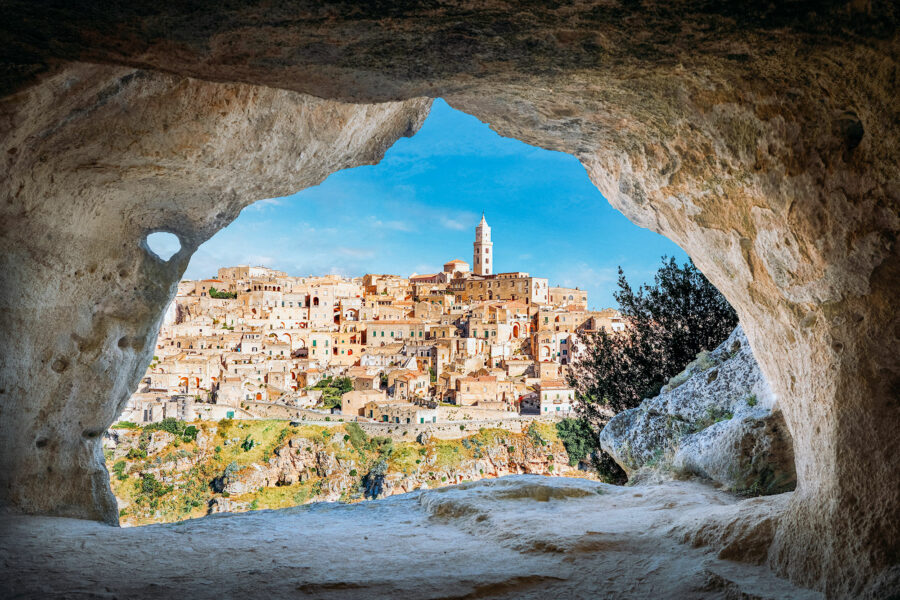
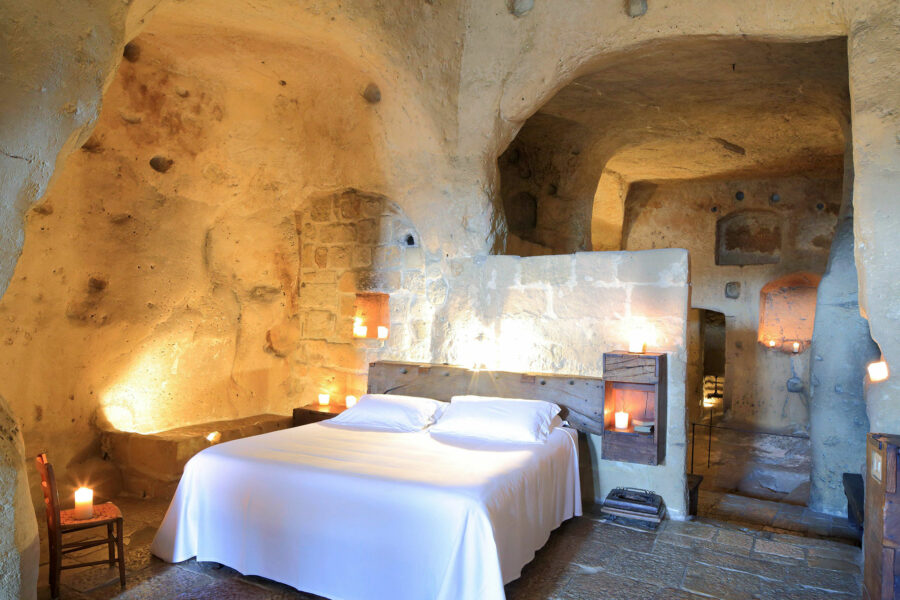
As part of its transformation, many of the cave homes in Matera have been turned into beautiful hotels and Airbnbs for tourists. We stayed in one, it was very cool! Literately cool, because your sleeping in a cave — LOL!
You’ll find a bunch of accommodation options at the end of this post if you’d like to stay in a cave hotel during your own visit (I highly recommend it). Staying in a boutique cave hotel is an experience everyone should have at least once, and there really aren’t that many destinations like Matera where you can do it.
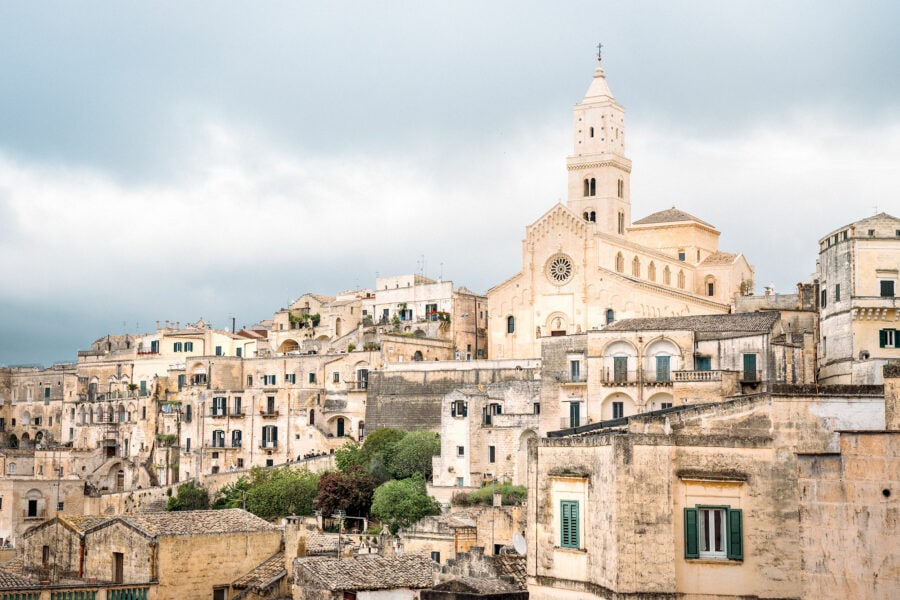
Probably the most prominent building in Matera’s sassi, the 13th-century Cathedral of the Madonna della Bruna and Sant’Eustachio has excellent views of the area. It was built on a ridge that forms the highest point of the city of Matera and divides the two sassi neighborhoods.
The front of the church is dominated by a rose window with sixteen rays, surmounted by the Archangel Michael. The interior of the cathedral is full of amazing stained glass, sculpture, intricate alters, golden ceilings, and colorful frescoes.
As someone who doesn’t get very excited about churches, I think it’s definitely worth a look inside this one.
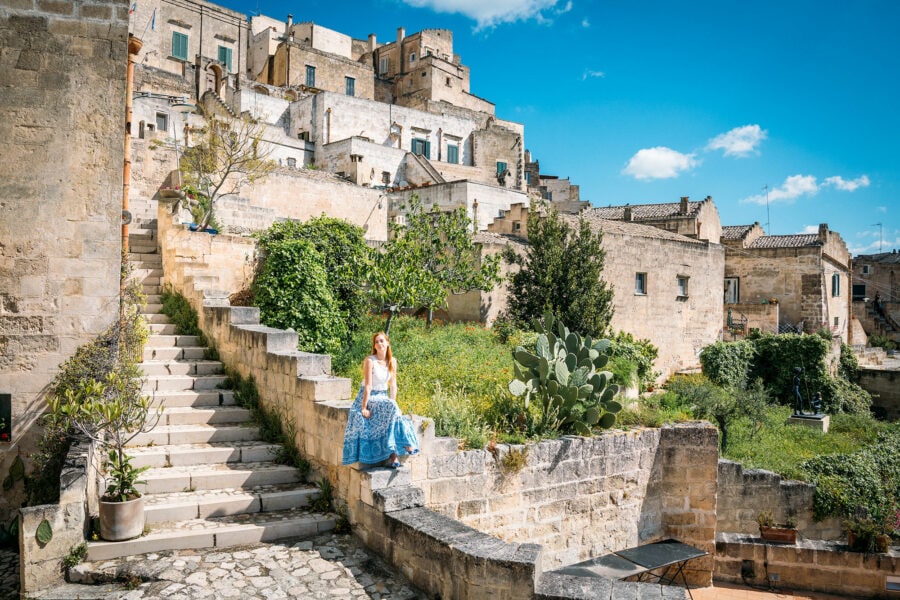
MUSMA is Matera’s Museum of Contemporary Sculpture, partially located in the impressive Palazzo Pomarici building (known locally as the hundred-room palace). It showcases contemporary art from within the grottoes of the Sassi.
Sculpture presented in underground vaults and small niches carved in the calcareous walls, displayed on blocks of volcanic tuff rock.
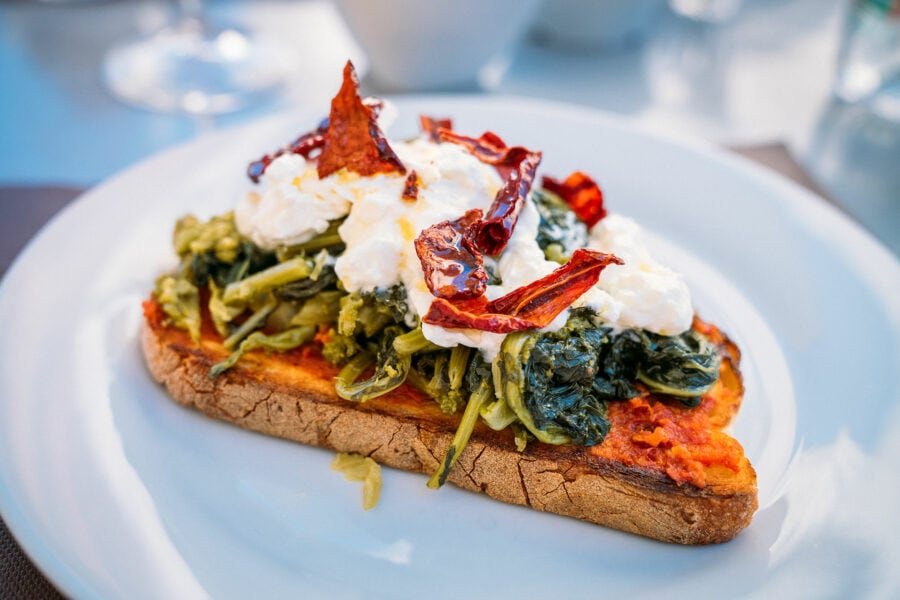
While much of Italy is known for its delicious pizza and fresh pasta, Matera has a slightly different traditional cuisine — bread! Pane di Matera is a sourdough bread made from semolina dough, natural yeast, salt, and water.
Throughout Matera you’ll find restaurants that serve their special local bread in all kinds of ways. The unusually-shaped (much like a stone) loaf can be served with cheese, as bruschettas, or in local dishes like Cialledda Materana ( featuring onions, tomatoes, and soaked Matera bread flavored with oregano and olive oil).
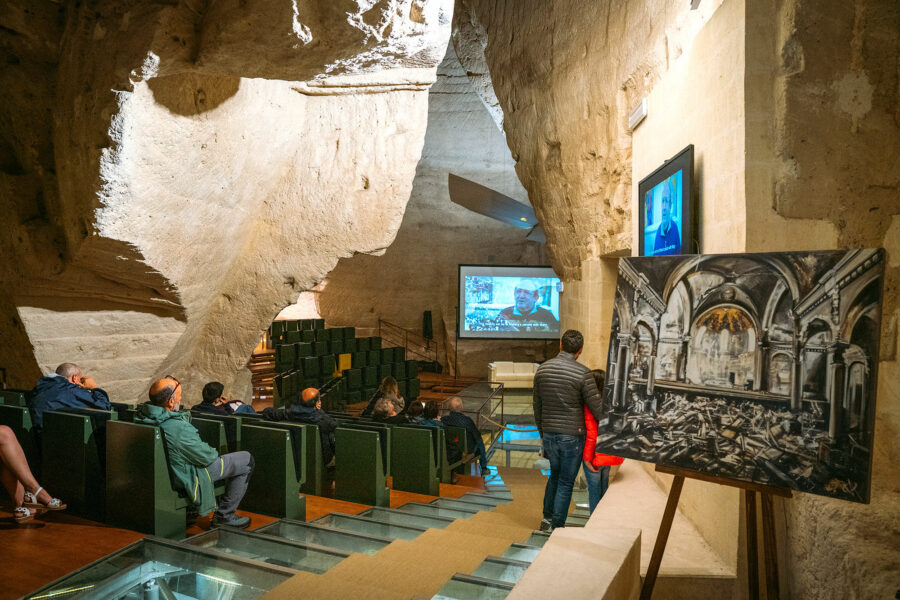
Casa Cava is a unique underground cultural center and auditorium located in the heart of Matera’s Sassi. It was originally a quarry for excavating “tuff” — a light, porous rock formed by volcanic ash. Tuff is the material used to build Matera’s homes.
Now it’s an auditorium that can accommodate 150 people. It’s used for concerts, performances, multimedia displays, art, and more. There was video presentation when we visited (in Italian with English subtitles) which explains the history of Matera and is very interesting.
There is a small €3 EURO entry fee.
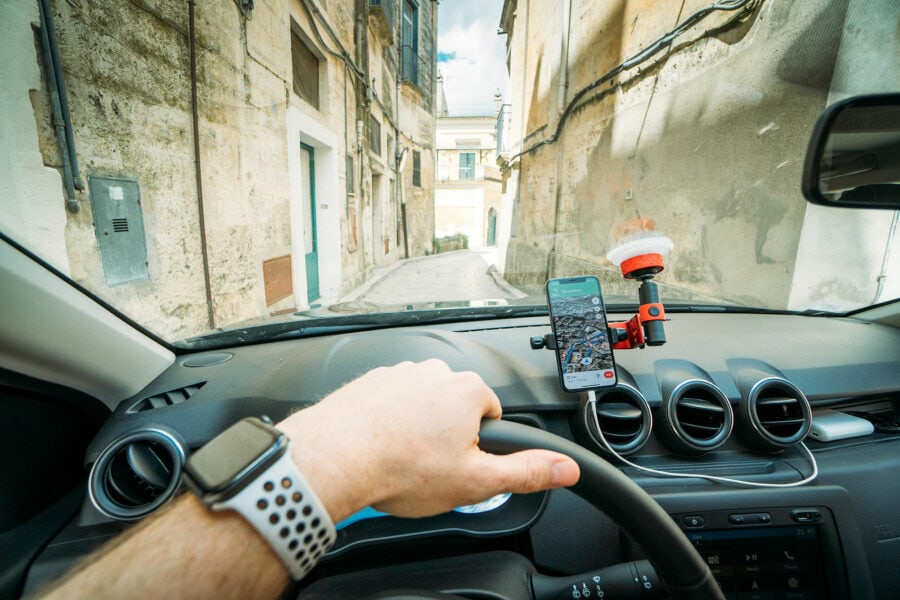
Most people get to Matera through the city of Bari, where there’s a major train station and airport. Search for the cheapest flights to Bari on Skyscanner.com. From Bari, you can rent a car like we did, or take a slow commuter train to Matera.
The best site to book your car is with Discover Cars. They search both local and international car rental companies to help you find the best possible price. This is the easiest way to rent a car and drive in Italy.
Renting a car offers the best flexibility to explore more remote and less touristy spots around Italy. It’s my favorite way to get around when I travel!
You can take a train to Bari from other major cities in Italy. From Bari, there’s a private commuter train the leaves from the Bari FAL train station that takes about 1.5 hours to reach Matera. Tickets cost about €5 EURO each way.
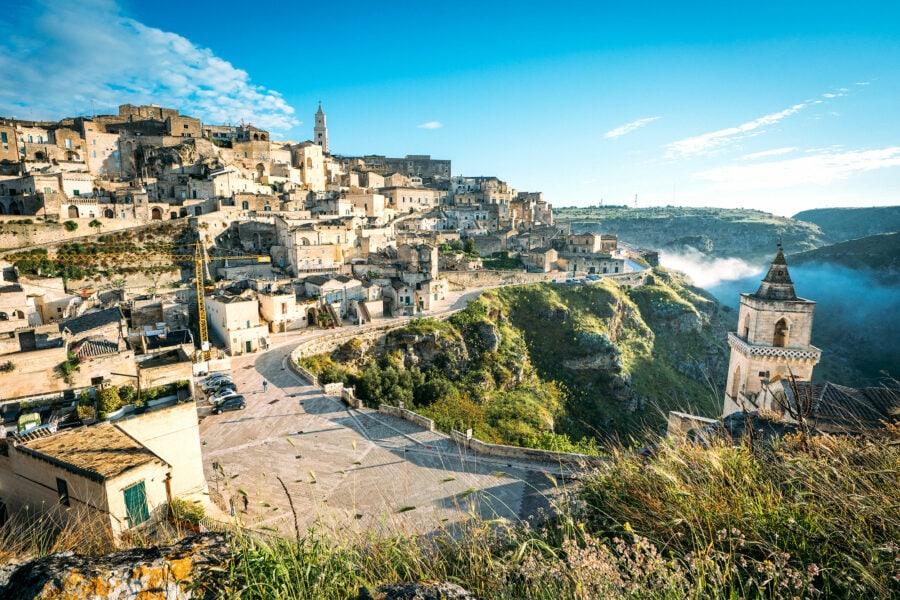
Accommodation in Matera can range from budget to luxurious. There are two sections of the city, the “new” town, and the “old” town (called Matera Sassi). The Sassi neighborhoods are where all the cool cave hotels are located.

| Travel Planning Resources For Italy |
|---|
| Packing Guide Check out my travel gear guide to help you start packing for your trip. Book Your Flight Ready to fly? Here’s how I find the cheapest airline flights. Rent A Car Discover Cars is a great site for comparing car prices to find a deal. Cheap Accommodation Learn how I save money booking hotels & vacation apartments. Protect Your Trip Don’t forget travel insurance! Protect yourself from possible injury & theft abroad. Read why you should always carry travel insurance. |
This is a post from The Expert Vagabond adventure blog.